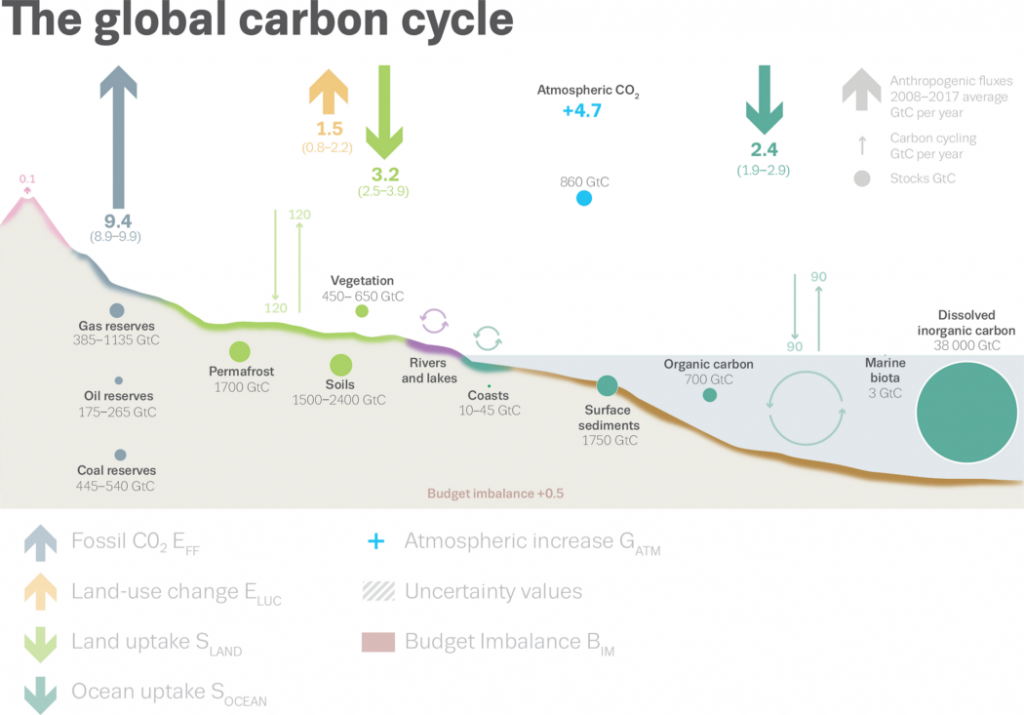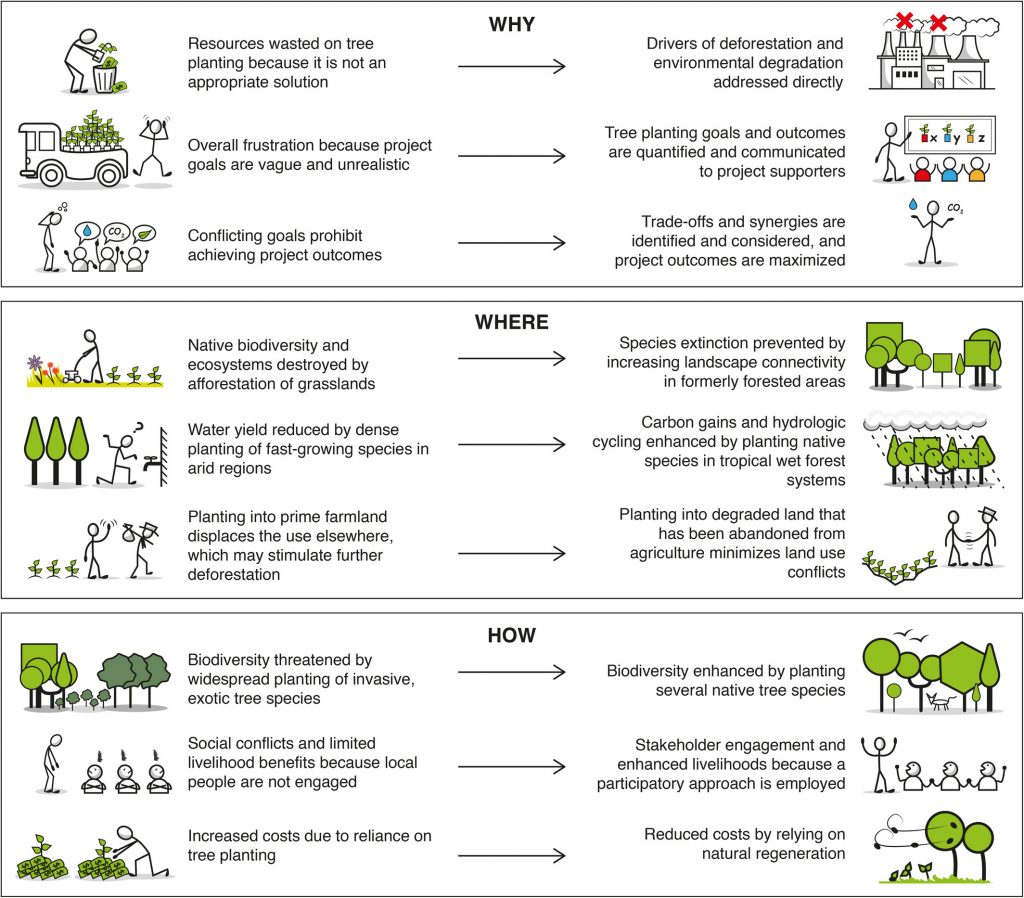Carbon sinks are systems that absorb more carbon from the atmosphere than what they release. The largest carbon sinks in the world are forests and oceans, absorbing around 50% of the carbon dioxide emissions (National Oceanic and Atmospheric Administration, 2020). These systems capture the carbon and stores them below the Earth’s surface as well as in organic matter, such as in plants.
Carbon sources do the opposite. They release more carbon into the atmosphere than the carbon dioxide (CO2) molecules that they absorb. Examples of these processes include burning fossil fuels and rearing cattle.
Having CO2 in the atmosphere is vital for our survival since it traps heat from the sun. If it was not present, the Earth would be too cold for humans to survive. However, too much CO2 can also trap too much heat, making the Earth too hot.
Carbon sinks are a crucial part of the carbon cycle (Fig 1), which is the process of carbon atoms moving between the atmosphere and the environment. Balancing the amount of carbon that carbon sinks absorb and the amount that the carbon sources release into the atmosphere keeps the concentration of CO2 in the atmosphere at the optimum level for survival.

The Problem
CO2 levels are rising and climate change models tell us that higher CO2 concentration in the atmosphere is a major factor in causing this rise. There are two main reasons why CO2 concentrations are increasing:
- Human activity is releasing more and more carbon into the atmosphere. Furthermore, this amount will continue to grow as the population and the energy needs of the people increases.
- Humans activity is destroying the carbon sinks, which includes deforestation. One study estimates that there is now half the number of trees on Earth compared to before human civilisation (Crowther et al, 2015). Additionally, natural minerals which store carbon, such as coal, are being mined and turned into carbon sources.
At the same time, many studies show that forests are also becoming less efficient at storing carbon, while rising temperatures and droughts are causing trees to die and dry out. Therefore, forests are also losing their ability to absorb carbon. One paper showed that the Amazon rainforest is likely to become a carbon source in the future (Hubau, 2020). Meanwhile, African forests are also slowly going to reach a similar fate.
Surprisingly, the CO2 absorption in oceans may also be increasing (Rosane, 2019). With oceans absorbing a third of the carbon emissions, this sounds promising. However, this is at the cost of acidifying oceans, leading to uninhabitable environments for sea creatures.
How to make carbon sinks more efficient
The solution to the first aforementioned problem is reducing CO2 emissions. Some ways of doing this include switching from fossil fuels to renewable energy. However, this will not be enough to stop CO2 levels from rising.
The volume of carbon that carbon sinks remove from the atmosphere needs to increase. One proposed way to do this is to directly remove carbon using artificial carbon sequestration. This method uses machines to filter CO2 out of the air, creating an artificial carbon sink. Some ways of doing this include:
- Direct capture of CO2 emissions from coal-fired power stations and injecting it deep under Earth’s surface
- Injecting CO2 into deep saline aquifers, which are sedimentary rocks saturated with saline water (Celia et al., 2015)
- Placing algae near light sources that can absorb CO2 and emit oxygen.
However, an EASAC report suggests that these methods are likely to be high cost and may negatively impact the environment. Additionally, they alone will not be enough to offset carbon emissions.
Another possibility is turning infrastructures into carbon sinks. Producing mineral-based construction materials, such as cement, steel and bricks releases a large amount of carbon. One paper suggested that using bio-based alternatives, such as bamboo and cross-laminated timber (CLT) could turn infrastructure into man-made carbon sinks, whilst reducing emissions as well (Chrukina, 2020).
Trees: The best carbon sinks?
In 2019, a paper made waves for estimating that reforestation could lead to up to a 25% increase in tree cover, absorbing an extra 200 billion tonnes of carbon dioxide in woodland and forest areas (Bastin et al., 2019). This estimate was made using models that located areas that could support trees (excluding agricultural land and naturally tree-less areas). However, this projection is under the assumption that carbon emissions are brought to zero.
Some researchers have found this estimate to be too optimistic, questioning the feasibility of forest growth in the areas identified as potential reforestation locations (Carrington, 2019). However, other studies showed that recovering tree land coverage could have a huge potential for absorbing carbon as well (Fargione, 2018).
These findings have translated into the growing popularity of tree planting organisations. However, tree planting can have negative environmental impacts if not done correctly (see Fig 2). Some of these include:
- Destroying the natural landscape. Planting exotic trees can destroy native tree species and disrupt ecosystems. Similarly, planting trees in naturally bare landscapes, such as the prairies, can also hurt existing native wildlife by creating habitats for new predator species.
- Planting monocultures. This reduces the biodiversity and renders the forests and plantations at a greater risk of disease.
- Planting in areas with low water availability.
- Displacing agricultural land and forcing farmers to find land elsewhere, which can lead deforestation.

Moreover, these problems have been used as a strong point of contention for commentators, accusing tree planting organisations and campaigns of greenwashing. The Trillion Trees Act that was introduced by Trump in 2020 was one such example (Greenpeace, 2020). Plans to ‘restore’ forest areas in grassy biomes in Africa are also another example (Bond et al., 2020).
How to choose tree-planting organisations
To avoid these problems, it is important to check that a tree-planting organisation:
- Divulges which species it plants.
2. Plants only native trees.
3. Does not plant monocultures.
Ultimately, natural forest growth, rather than planting trees, is a more effective solution (Lewis et al., 2019). However, this will depend on preserving existing forests. Thus, working with environmentally-conscious tree-planting organisations to reduce carbon footprints is a step towards restoring carbon sinks.
THRIVE Project works with one such tree-planting organisation, treesforlife.org, which you can read about on our blog here.
References
National Ocean and Atmospheric Administration (2020). Ocean Atmosphere CO2 Exchange Dataset. Retrieved from https://sos.noaa.gov/datasets/ocean-atmosphere-co2-exchange/
Crowther, T., Glick, H., Covey, K. et al. (2015). Mapping tree density at a global scale. Nature 525, 201–205. doi: 10.1038/nature14967
Hubau, W., Lewis, S.L., Phillips, O.L. et al. (2020). Asynchronous carbon sink saturation in African and Amazonian tropical forests. Nature 579, 80–87. doi: 10.1038/s41586-020-2035-0
Rosane, O. (2019). Oceans absorb almost 1/3 of global CO2 emissions, but at what cost? Retrieved from https://www.weforum.org/agenda/2019/03/oceans-do-us-a-huge-service-by-absorbing-nearly-a-third-of-global-co2-emissions-but-at-what-cost
Celia, M. A., Bachu, S., Nordbotten, J. M., and Bandilla, K. W. (2015). Status of CO2 storage in deep saline aquifers with emphasis on modeling approaches and practical simulations. Water Resourc. Res., 51, 6846– 6892, doi:10.1002/2015WR017609.
Churkina, G., Organschi, A., Reyer, C.P.O. et al. (2020). Buildings as a global carbon sink. Nat Sustain 3, 269–276. doi: 10.1038/s41893-019-0462-4
Carrington, D. (2019). Tree planting ‘has mind-blowing potential’ to tackle climate crisis. Retrieved from https://www.theguardian.com/environment/2019/jul/04/planting-billions-trees-best-tackle-climate-crisis-scientists-canopy-emissions
Bastin, J., Finegold, Y., et al. (2019). The global tree restoration potential. Science 365(6448), 76-79. doi: 10.1126/science.aax0848
Fargione, J., Bassett, S., et al. (2018). Natural Climate Solutions for the United States. Science Advances 4(11), eaat1869. doi: 10.1126/sciadv.aat1869
Greenpeace. (2020). Planting Tree Farms No Panacea for Climate Change. Retrieved from https://www.greenpeace.org/static/planet4-international-stateless/2020/03/af32dec9-planting-tree-farms-no-panacea-for-climate-crisis-greenpeace-march-2020.pdf
Bond, W., Stevens, N., et al. (2019). The Trouble With Trees: Afforestations Efforts for Africa. Trends in Ecology and Evolution 34(11), 963-965. doi: 10.1016/j.tree.2019.08.003
Lewis, S., Wheeler, C., et al. (2019). Restoring Natural Forests is the Best Way to Remove Atmospheric Carbon. Retrieved from https://www.nature.com/articles/d41586-019-01026-8
Brancalion, P. & Holl, K. (2020). Guidance for Successful Tree Planting Initiatives. Journal of Applied Ecology 57(12). doi: 10.1111/1365-2664.13725
Quere, C., Andrew, R., Friedlingstein, P. et al. (2018). Global Carbon Budget 2018. Retrieved from https://essd.copernicus.org/articles/10/2141/2018/






















